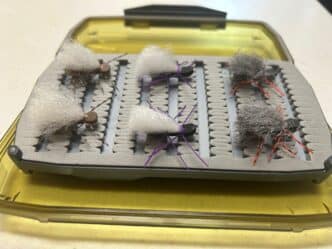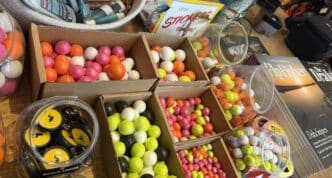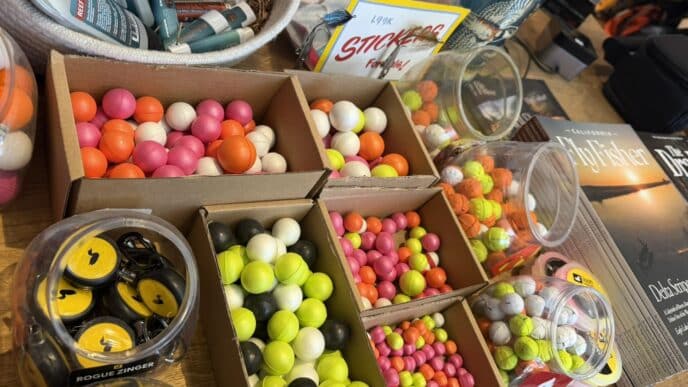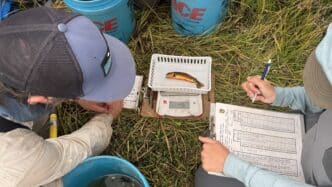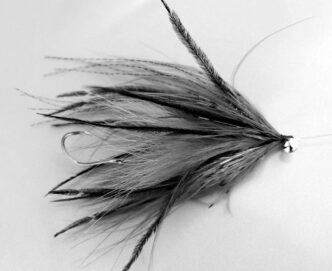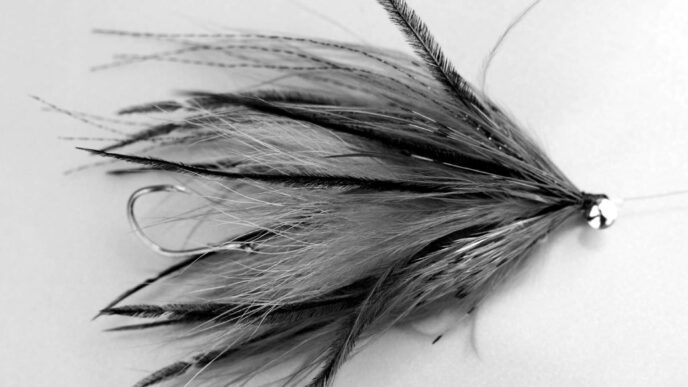It was a cool, rainy morning on the Trinity River— perfect steelhead weather—and I watched as Kianna made her first cast of the day. It was a good presentation, and I followed her indicator intently as it floated drag-free through the best part of the run, willing a fish to take the nymph suspended beneath it. When the fish instead rose and took the dry she was using as an indicator, we were both momentarily shocked – was that even an option?! Recovering nicely, she set the hook, and soon after, we were admiring the pretty little wild fish in the net. A steelhead on a dead-drifted dry!
For years, I’ve been an advocate of using yarn indicators instead of the more traditional plastic or foam floats. Properly constructed, yarn floats higher, avoids the nervous movement on the water I experience with some of the hard-bodied indicators (that constantly give off confusing, false strike “tremblings”), and is pulled beneath the surface much more easily, thereby alerting anglers quickly to even the softest takes. As well, I’ve noticed that heavily pressured fish will sometimes spook as a hard indicator floats over them, whereas yarn rarely seems to elicit this response. Yarn is also infinitely adjustable, bulk-wise. One can fashion a highly buoyant, unobtrusive indicator out of just a few strands of brightly-colored yarn that will not spook educated fish on technical, slow-moving water like Hat Creek or Fall River, or create a bulkier model capable of holding up a couple of heavy stonefly nymphs in fast, broken flows.

Admittedly, yarn takes a bit more effort to construct, needs to be dressed with floatant a few times during the day, and the simple design I employ does not allow for adjusting the depth of the nymphs (more on this adjustability issue later). With this in mind, I absolutely understand why most guides use the more commercially available hard indicators, and if I’m honest, I might do the same in their shoes—they are effortless to use, float well enough, demand zero maintenance, and allow for easy depth adjustments of the nymphs. Yet, fishing on my own, I have always appreciated the advantages of yarn.
Having said all that, I have in recent years largely moved away from yarn and now employ various sizes of Chubby Chernobyl dry flies as indicators in my nymph rigs. Though hardly a new concept—guides in the Rocky Mountains, especially, have been doing this for years—it has been slower to catch on here on the West Coast. Years ago, the Fly Shop guide, Shane Kohlbeck, pioneered the technique on the Lower Sac, and his remarkable success has convinced the rest of us of its effectiveness. One obvious advantage of using a Chubby as an indicator is that you add another fish-attracting/fish-catching option to your setup. This was actually a bit of a surprise to me when I began experimenting with this system, as our Northern California trout streams are not generally known as large terrestrial dry fly fisheries. Yet most days, I will have fish eat my “indicator”, an event that never fails to catch me by surprise. Most recently, as in the aforementioned Trinity River experience, I have had a good number of steelhead in that fishery pass by the nymph droppers, preferring to rise to the surface for the Chubby. I’m guessing these autumn steelhead are mistaking the Chubby for an October caddis adult, just as early-season Hat Creek and Upper Sacramento River trout likely take it for a struggling golden stone, or salmonfly egg-layer. Whatever the reasons, it adds significantly to the daily number of takes!
In some ways, fishing a Chubby—especially the Double Chubby with its extra foam body layer—is like using an improved yarn indicator. Between the doubled foam and thick yarn wings (essentially the same yarn I use to make indicators), I achieve the same level of buoyancy, the advantage of adding an extra fly to the rig, and a system that is less air-resistant when casting. And I have never observed fish spooking from this dry fly indicator—quite the opposite, actually, as many fish are attracted to it. I surmise this is because it resembles something natural to them, both in how it lands, floats, and behaves on the water, unlike hard and even yarn indicators. I will still sometimes use tiny yarn indicators when fishing to nervous trout on flat, show-moving water, or oversized versions when plying deep, roiling water with lots of weight on the leader, but those are normally the only exceptions.
As with my yarn indicators, this dry/dropper rig does not allow for easy depth adjustment. To alter the depth at which your nymphs drift, you need to add or subtract tippet length below the dry fly. While I don’t find this added step problematic, the truth is I almost never bother. What I’ve found is that in most situations, trout are used to moving up and down in the water column to intercept drifting nymphs, so it is rarely necessary to have the flies right on the bottom. For most rivers, I set the bottom nymph about four to six feet from the dry, and this works for everything but the shallowest (where I normally fish a single nymph about two feet below the dry) or deepest water (where I might extend the tippet drop to seven or eight feet). Having a longer drop than this can be problematic in moving water, as the nymph drop is buffeted by currents, compromising the tautness of the tether between dry fly and nymph, causing there to be too long a delay between a fish eating your nymph and that strike being telegraphed to the Chubby.
Finally, as a general rule, I use a #10 Double Chubby when fishing multiple heavy nymphs in choppy water, or a #14 Mini Chubby when fishing a single nymph in gentler flows. I’ve rarely found that color is particularly important for this dry. I typically use an 8-foot 3X TroutHunter nylon leader between the fly line and the Chubby, and TroutHunter Fluorocarbon tippet between the Chubby and the nymph(s)— 3.5X for larger nymphs and fish, and 4X for smaller bugs and more traditional trout sizes.



